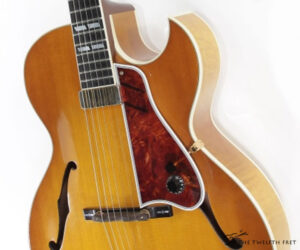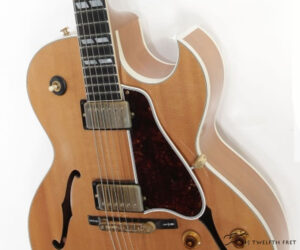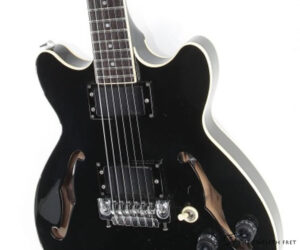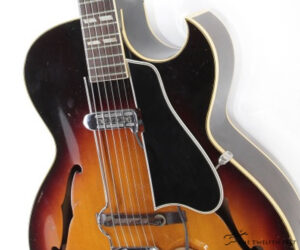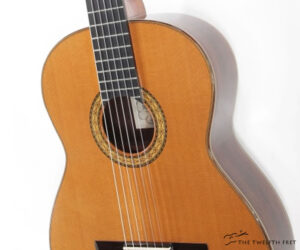When originally introduced in 1912, the Gibson L-4 appeared as a 16 inch wide, oval hole archtop, switching to F-holes in 1935. The cutaway body L-4C appeared in 1949 and by 1956 had displaced the non-cutaway model. In Gibson’s naming convention, the ‘C’ was dropped some years ago.
Laminate
Here we’re looking at a Gibson L-4CES (CES for Cutaway Electric Spanish) in Natural lacquer finish, dating to January 11 1989 and built at Nashville. This example is in overall very good, clean and original condition with light wear to the back finish and very light fret wear. The gold plating on the pickups shows typical wear to the bass edge, but the bridge, tailpiece and tuner plating has very little wear.
Built from 1991 to 2003 in Memphis, the Gibson ES-135 P100 was a single Florentine cutaway, semi-hollow thinline with a pair of P100 hum-cancelling pickups. From 1956 to 1958, the ES-135 existed as a renamed ES-130, a full-depth, single-cutaway archtop with one or two P-90 pickups. The ES-130 was introduced in 1954, renamed in 1956 to the ES-135, and discontinued in 1958.
Here’s a great condition Ibanez AM-70 Artist Compact Thinline Archtop in Black finish, dating to 1985, its first year. This model was only built until 1987. With proportions somewhat like the Gibson ES-339 models, the Ibanez AM-70 is a scaled down version of the classic ES-335 style models. The top, back and sides are laminate Birch with a Maple center block. The neck is 3-piece Maple with a bound Indian Rosewood fingerboard.
This instrument has sold
MORE →Seen here is a Gibson L-4C cutaway archtop acoustic guitar with an original DeArmond Rhythm Chief 1100 pickup with its ‘Monkey on a Stick’ mount. This fine vintage guitar very much looks the part, and it plays well. The 16-inch wide Gibson L-4C was introduced in 1949 and came to replace the non-cutaway L-4. That model first appeared in 1912 as an oval-hole archtop, with F-holes becoming available in 1935 and finally discontinued in 1956.
The M. Sakurai No.8 Cedar Top Classical guitars, indeed the entire line of Masaki Sakurai models, are under-appreciated gems. The set of guitars with labels reading ‘M. Sakurai Supervised by M. Kohno’ are from the period where Masaki Sakurai was still learning the craft from his uncle, Masaru Kohno.
This instrument has sold
MORE →